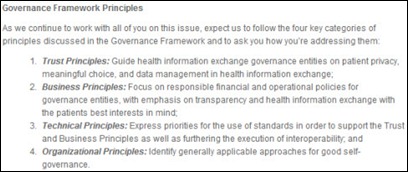Ageed Mike, "patients are the widgets that must be processed" additionally when it costs close to $3,700 a month for…
News 5/8/13
McKesson reports Q4 results: revenue down 3.4 percent, adjusted EPS $1.45 vs. $2.09, missing expectations on both. In the earnings call, John Hammergren mentions that the company will exit its international technology and hospital automation business. I don’t know which product lines hospital automation includes, for instance whether that means the medication packaging and distribution systems business (ROBOT-Rx, AcuDose-RX, etc.) Technology solutions revenues were up 3 percent, but profit was down 16 percent, “well below our expectations.”
Reader Comments
From The PACS Designer: “Re: Windows 8. The unfriendly start menu for Windows 8 has Microsoft scrambling to fix the problem.” The company admits that its flagship product has a steep learning curve as it forced users to use its touchscreen-friendly tile-based graphical system instead of giving them the familiar Start button.
From Kaye: “Re: HIStalk sponsorship. This remains the best value we get for the money in advertising!” Thanks – that’s a nice comment and we appreciate it, especially coming from a company that has sponsored multiple HIStalk sites since 2009.
From Anesthesiologist: “Re: Google Glass. How can I partner with companies to develop applications that might be useful in the perioperative setting?” If you’re interested in working with this doc, e-mail me and I’ll forward to him.
From Arcane: “Re: Epic implementation. Do you know of a source for rollout and post-live support staffing numbers?” I have many readers and consulting firms that have implemented Epic, so please add a comment with your thoughts.
Acquisitions, Funding, Business, and Stock
Greenway reports Q3 results: revenue up 3 percent, adjusted EPS $0.01 vs. $0.08, beating earnings estimates of –$0.02 but falling well short of revenue expectations. The company blames a faster-than-expected shift to subscription-based pricing. Shares are near their 52-week low. President and CEO Tee Green also said in the earnings call that with HITECH in the rear-view mirror, buyer fatigue has set in over the past several quarters. Training revenue was also impacted, he said, by customers choosing train-the-trainer and pushing training back to after the quarter’s close. He also said that Greenway’s participation in CommonWell hasn’t resulted in any sales (without expressing puzzlement at the analyst who apparently thought it might) but said more companies are signing on.
InstaMed raises $3.5 million in an internal round of funding.
Healthcare transaction processing firm MediSwipe signs a term sheet with a Chicago-based PE fund to receive up to $600,000 over the next nine months.
Vocera Communications reports Q1 numbers: revenue down 3.1 percent, EPS –$0.14 vs. -$0.08. CEO and Chairman Bob Zollars says the company saw an increase in new customer signings but did not complete several significant hospital deals.
Siemens Healthcare posts a 4.9 percent increase in Q1 profits, although revenues fell 2 percent.
Qualcomm Life acquires HealthyCircles, a startup that supports the secure sharing of patient data.

WebMD CEO Cavan Redmond, who has been on the job less than a year, will leave the company, along with CFO Anthony Vuolo.
Perceptive Software blames recent acquisitions for its decision to lay off about 40 employees, or three percent of its workforce.
Sales
Massachusetts General Hospital selects eHealth Connect Referral Portal from eHealth Technologies to support two-way communication between the hospital and its referring doctors.
East Kent Hospitals University NHS Foundation Trust chooses Harris Corporation’s Clinical Integration Platform to integrate data from six clinical systems across five sites. East Kent will also use Imprivata’s OneSign single sign- on technology.
Upper Peninsula Home Health, Hospice and Private Duty (MI) will implement the Procura for Hospice solution.
SCL Health System (CO) selects Leap-10 from Wolters Kluwer Health to streamline its conversion to ICD-10.
Amarillo Legacy Medical ACO (TX) selects eClinicalWorks Care Coordination Medical Record to advance its ACO objectives and coordinate care among its 100+ provider members.
Physical Rehabilitation Network will deploy NextGen Healthcare’s EHR, PM, PatientPortal, and NextPen products across its 100+ locations and use NextGenRCM Services for revenue cycle management.
Virtual Radiologic signs a five-year deal with Visage Imaging to implement Visage 7 Enterprise Imaging Platform for its 400 radiologists in a read-anywhere environment.
People
Ernst & Young names Intellect Resources President and CEO Tiffany Crenshaw a finalist for Entrepreneur of the Year 2013 in the Southeast region.
Former Cerner VP Ian Chuang, MD joins Netsmart Technology as CMO/VP of healthcare informatics.
Former National Coordinator Robert M. Kolodner, MD joins telehealth provider ViTel Net as VP/CMO.
Care Team Connect names Richard Popiel, MD (Regence BCBS) to its board.
Healthcare software solution provider MedicaSoft, LLC appoints Mike O’Neill (VA Center for Innovation) CEO.
Beebe Medical Center (DE) names Michael J. Maksymow, Jr. (Continuum Health Alliance) VP/CIO.
QPID hires Gary Zakon (ModelLogic) as VP of engineering and Caroline Smyth (Smyth Consulting) as VP of sales.
Eric J. Topol, MD is named editor-in-chief of Medscape. What’s most interesting to me is that his ongoing full-time employer Scripps Clinic apparently Photoshopped his black suit jacket to look like a white lab coat in the pictures above from their site.
Announcements and Implementations
Access is named as a Meditech Collaborative Solutions vendor, offering Meditech customers an integrated solution to capture and upload electronic signatures and data collected from clinical systems and medical devices.
Johns Hopkins Medicine integrates Epic with Hyland Software’s OnBase enterprise content management solution in its ambulatory and inpatient departments.
Philips launches Healthcare Transformation Services, a global business unit to provide consulting services to hospitals and health systems.
Trustwave introduces a mobile security practice to help enterprises with their BYOD strategies.
HCA MidAmerica Division equips seven hospitals and multiple physician offices in its Midwest region with Accelarad’s medical imaging solution.
Lifespan (RI) completes its rollout of the the TeamNotes electronic documentation system from Salar.
PerfectServe launches DocLink, a secure communications network for physician-to-physician communication.
Government and Politics
ONC publishes a governance framework for trusted health information exchange to help HIEs and other healthcare organizations understand ONC’s priorities and how to align with “national priorities.”
CHIME recommends in a letter to six Republican senators a one-year extension for Stage 2 MU before progressing to Stage 3. CHIME contends the extra year will give providers the opportunity to maximize their EHR technology to achieve the benefits of Stage 1 and 2 and give vendors time to “prepare, develop and deliver needed technology to correspond with Stage 3.”
Deputy National Coordinator Judy Murphy, RN kicks off National Nurses Week with a blog post on the role of nurses in healthcare IT and an invitation for nurses to share their stories.
UCSF creates the Center for Digital Health Information. It will be led by UCSF Medical Center CMIO Michael Blum, MD, who will assume the newly created position of associate vice chancellor for informatics and who will continue to lead its Epic implementation (physician leaders of the project are pictured above, with Blum on the left). Current projects include a team-based communications platform, an open source diabetes management system, a Web-based collaboration tool for virtual tumor boards, and a social media-based cardiovascular study.
Kaiser Permanente Center for Total Health will hold a Google Glass event in Washington, DC the evening of June 18.
South Carolina-based Iron Yard launches the Digital Health Program accelerator and incubator in the Spartanburg area.
Technology
Bloomberg TV covers the technology used by Palomar Medical Center (CA) and the "hospital of the future.” Palomar Health Chief Innovation Officer Orlando Portale is featured.
Other
An Imprivata-sponsored study finds that clinicians waste 45 minutes per day in using inefficient communication systems such as pagers.
Hospital IT leaders are focused on accommodating greater mobile and wireless connectivity to their networks and with ensuring the security of patient data in BYOD environments, according to a HIMSS Analytics study.
A Raleigh, NC clinic warns patients that it was scammed by a company that claimed it would digitize the practice’s old X-rays, but instead harvested their silver content and then destroyed the films.
University of Rochester Medical Center warns 537 patients that their PHI may have been compromised when a resident lost a USB drive containing quality improvement information. The hospital thinks it went to the laundry and was destroyed.
John Halamka reports on new Meditech 6.1 development after mixed response to Version 6: a cloud-hosted system based on standards, Web-centric and mobile-enabled, with both inpatient and outpatient capabilities, complete with analytics, a PHR, and care management tools. He says it will ship in 2014.
Drug chain CVS shuts down its drug company-sponsored refill reminder program because of limitations imposed by the new HIPAA Omnibus Rule on using patient information for marketing.
Weird News Andy refers to this story as “brain drain.” A man who thought his year-round runny nose was caused by allergies finds that it’s actually brain fluid leaking from a tiny hole. It’s been fixed and he’s fine. WNA also likes this story, in which researchers claim to have found the cause of graying hair (hydrogen peroxide buildup in the hair follicle) and a cure for both gray hair and vitiligo (a proprietary treatment involving a UV-activated enzyme).
Sponsor Updates
- API Healthcare and The DAISY Foundation offer The Nurses Week Story Contest, with submissions from nurses due May 12.
- McKesson releases version 13.0 of its Homecare solution.
- Orion posts a video featuring Orion clients that have solved interoperability challenges.
- More than 200 hospitals using CareWorks content management system from CareTech Solutions have received 32 Website awards in the past year.
- Truven Health Analytics finds that healthcare spending is 20 percent higher for public sector employees than for the private employee population.
- Passport Health Communications names Texas Health Resources, Trinity Medical Center (AL), and Kadlec Regional Medical Center (VA) winners of its Leaders at the Forefront of the Healthcare Experience contest for best healthcare access management practices.
- Gwinnett Medical Center (GA) discusses how using RelayHealth services helped the hospital remove patient billing obstacles.
- iHT2 hosts a May 29 Webinar on security, privacy, and compliance risks in a post-reform era.
- Greenway Medical President and CEO Tee Green discusses the compatibility of innovation and other topics with PGA tour partner Jason Dufner.
- Red Herring names Kony Solutions a finalist for its Top 100 North America award, which honors the year’s most promising private technology ventures.
- EBSCO announces its intent to collaborate with the American College of Physicians to give ACP access to its DynaMed evidence-based clinical summary resources and literature surveillance.
- Gartner names Health Catalyst to its list of Cool Vendors in Healthcare Providers 2013 and profiles Shareable Ink in its update on 2011 winners.
- Greenway Medical releases agenda details for its PrimeLEADER 2013 user conference in Washington, DC August 22-25.
- CommVault launches a customer education services program that includes customized user training and access to online training courses for its Simpana software.
- ADP launches a Website to help clients and other employers plan for and comply with the Affordable Care Act.
- Nuance names seven healthcare organizations winners of its Voice of the Customer award for improving quality of care, reducing costs, and accelerating EMR adoption using speech recognition and clinical language technology.
- CCHIT extends EHR Module certification to the latest version of the Medseek Empower patient portal.
- TELUS Health and McGill University enter a three-year joint venture to conduct research on how best to use technology to improve health and healthcare delivery for Canadians.
Contacts
Mr. H, Inga, Dr. Jayne, Dr. Gregg, Lt. Dan, Dr. Travis.
More news: HIStalk Practice, HIStalk Connect.

































MrH,
I am aware of a couple of hospital systems that have started a CMIO search, interviewed applicants and chosen to restart the search rather than make an offer to existing applicants. Are you aware of intelligence showing how often that happens for the CMIO position compared with other Chief level corporate officers? Are there enough applicants? Or are hospitals being unreasonable in their quest?
Responding to the Epic Post Go Live Support question from ARCANE – we have found the annual Epic Customer Survey is the best source as it returns comparitive data for your site vs. other similarly sized sites using Epic.
Re: Epic implementation
I have 15 years experience implementing Epic from all sides: as an Epic employee, as a hospital IT director, and (currently) as a consultant with Hayes Management. You will want enough post-live resources to account for 3 areas: (1) daily support/maintenance, (2) rollouts, and (3) optimization work. Based on my experience, I would recommend the ratio of Epic support staff to physicians to range between 1:25 for smaller organizations (100-200 physicians) to 1:50 for larger organizations (600-800 physicians). This ratio is for an enterprise-wide install, with the analysts split evenly between ambulatory, inpatient, and revenue cycle. For example, I would recommend that a 600 physician organization rolling out Epic to have 35-50 Epic analysts overall with 12-17 EpicCare Ambulatory analysts, 12-17 EpicCare Inpatient analysts (Clin Doc, Orders, Willow, ASAP, etc), and 12-17 Revenue Cycle analysts (including analysts for registration, scheduling, HIM, and billing applications).
These numbers don’t include front-line enduser trainers, or staff to support interfaces, hardware, and networking. This staffing level is sufficient for routine support and maintenance, optimization, and a typical rollout schedule with one rollout team on each application. If you have a particularly aggressive rollout schedule, with multiple rollout teams, you will need to add more rollout resources.
TO: Arcane RE: Epic implementation. To piggyback on hmconsultant’s recommendation, I would add that clinical support staff also be included for pre-and post Go-Live support. My employer has supported multiple Epic implementations, and our clients have concluded clinical support is crucial. Deploying RN’s and physicians who are verse in the particular Epic modules and have Go Live experiecne is a huge plus in gaining rapid core staff adoption. We’ve typically seen ratios of 1 Epic support RN for every 4-6 core staff RN. Physician support varies widely, but typically around 1 Epic physican for every 6-10 core staff physician. These support clinicians hit the ground 1-2 weeks pre-GoLive and remain on assignment 3-5 weeks after the switch is turned on. They are very effective in elbow support, as they talk “clinic” language and have been in the cor staff’s shoes before and know the jitters associated with a conversion. Hope this helps!
@CMIOSearchingRedux – I think the hospitals are looking for someone that has already done everything they expect to do in the future and, finding mostly people who have had lesser roles, or have done part of what they want, keep looking. They don’t want to invest in people that likely could and allow them to learn on the job, and they don’t want someone internally to take the role (in itself a pretty poor idea).
In my opinion, any CMIO that has done the whole cycle and wants to do more implementations will be working for a consulting firm, because that’s the only way to do that. The rest of us who have gone through the whole cycle would rather get to the quality improvement piece (and not uproot our families, deal with new politics, etc.).
In response to Arcane question regarding Epic support, we have found a ratio of 1 Physician/Clinician at the elbow support to 15-20 beds on general wards, and 1: 10 ICU bed area or other critical areas such as OR have worked well for our clients. During post go live optimization that could be double to 1:50 bed ratios. Having Physician to Physician support really helps bring adoption and efficiency among your staff at the same time returning a higher ROI. Usually non-physician consultants can help in the first few days of navigating the software, but after that learning best practices and using EHR as a tool to improve patient care is best taught by our expert physician consultants.
Belated kudos to Tiffany Crenshaw of Intellect Resources on being named a finalist in the E&Y competition. Not only has she coined Big Break, a truly unique healthcare IT staffing event, but she is gracious and always quick to praise her team members and clients.
Does John really think Meditech is able to pull off its bold, new vision? Feels an awful lot like Allscripts trying to integrate with Eclipsys . . . biting off more than it can chew. Doesn’t really matter I guess. From the numbers I’m seeing, Obamacare is about to come collapsing down on itself. Too costly EMR implementations that’ll never provide the operational savings promised by Cerner director Sebellius, too little reimbursements from Medicare, and too many patients being d/c’d and kept out of the beds . . . just not adding up. And the money spend isn’t done as ICD-10 and Meaningful Use continues to drain IT and operational resources taxing budgets. The EMR implementation gravy train will be ending soon; probably why Judy outsourced that business so Epic is protected once the funds dry up and there’s a whole lot of expensive salaries wondering what they’re going to do next.